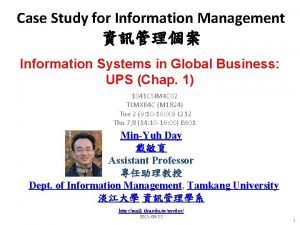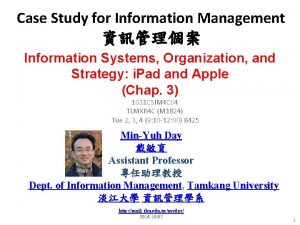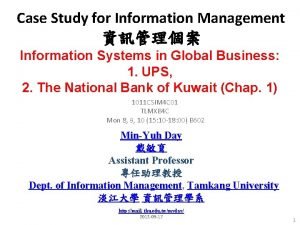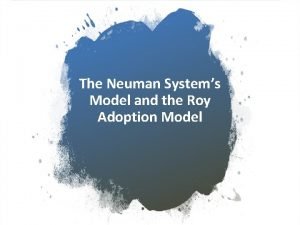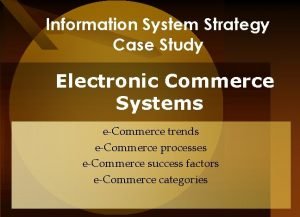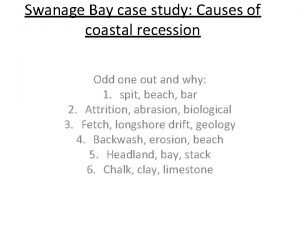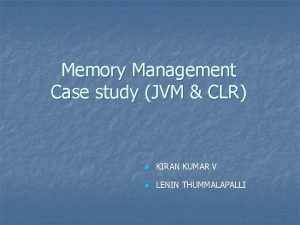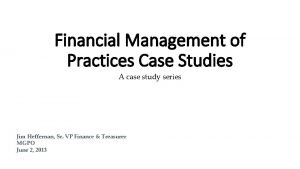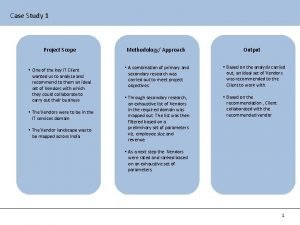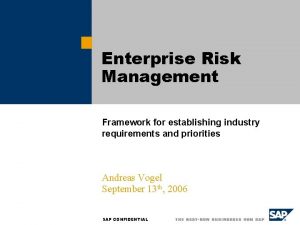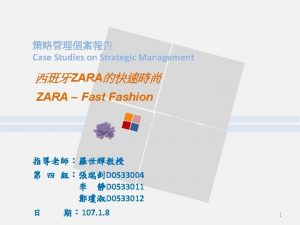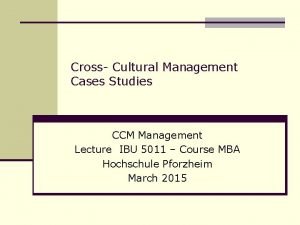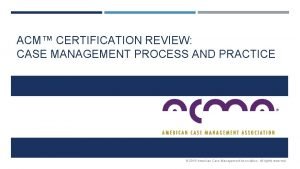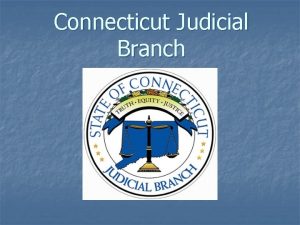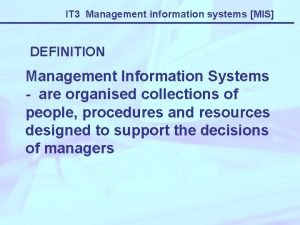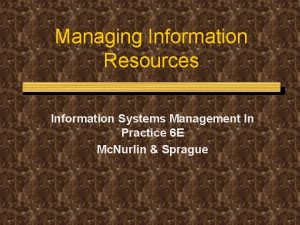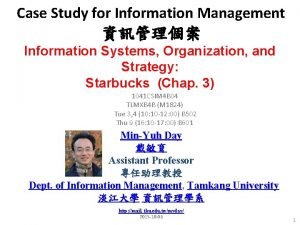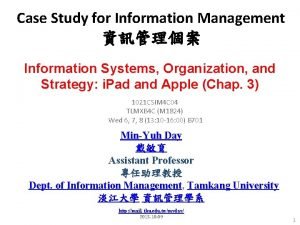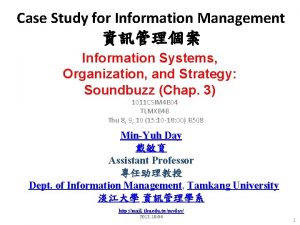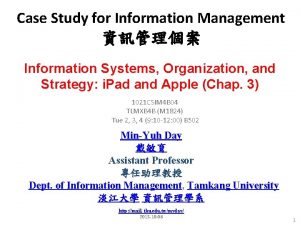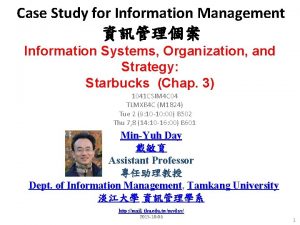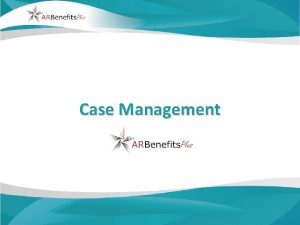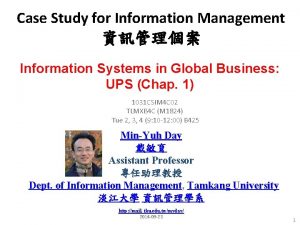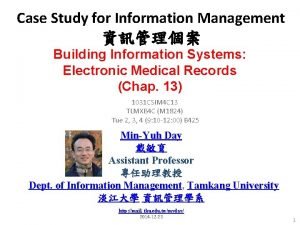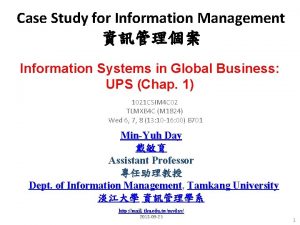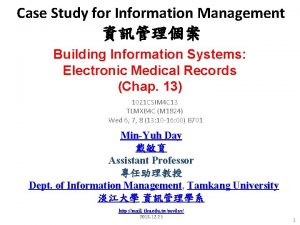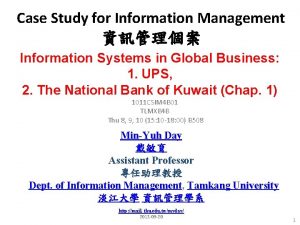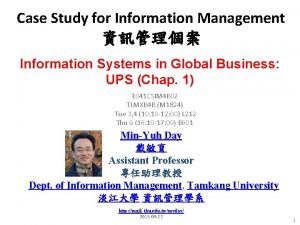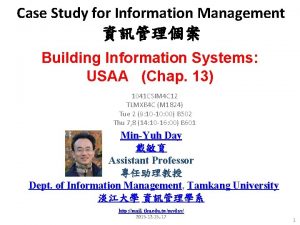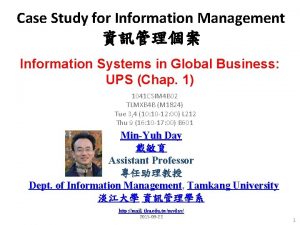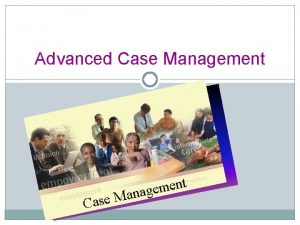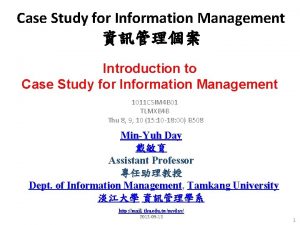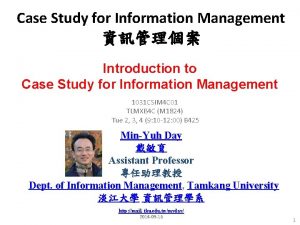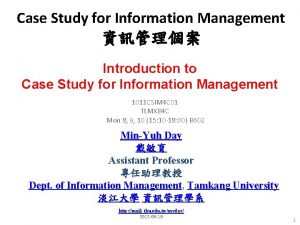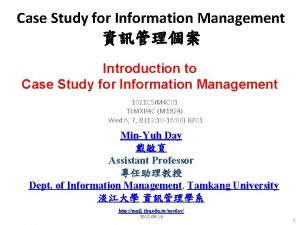Case Study for Information Management Information Systems Organization
































- Slides: 32

Case Study for Information Management 資訊管理個案 Information Systems, Organization, and Strategy: i. Pad and Apple (Chap. 3) 1031 CSIM 4 A 04 TLMXB 4 A (M 1824) Thu 8, 9, 10 (15: 10 -18: 00) B 608 Min-Yuh Day 戴敏育 Assistant Professor 專任助理教授 Dept. of Information Management, Tamkang University 淡江大學 資訊管理學系 http: //mail. tku. edu. tw/myday/ 2014 -10 -09 1

課程大綱 (Syllabus) 週次 (Week) 日期 (Date) 內容 (Subject/Topics) 1 103/09/18 Introduction to Case Study for Information Management 2 103/09/25 Information Systems in Global Business: UPS (Chap. 1) 3 103/10/02 Global E-Business and Collaboration: NTUC Income (Chap. 2) 4 103/10/09 Information Systems, Organization, and Strategy: i. Pad and Apple (Chap. 3) 5 103/10/17 IT Infrastructure and Emerging Technologies: Salesforce. com (Chap. 5) 6 103/10/24 Foundations of Business Intelligence: Lego (Chap. 6) 2

課程大綱 (Syllabus) 週次 (Week) 日期 (Date) 內容 (Subject/Topics) 7 103/10/31 Telecommunications, the Internet, and Wireless Technology: Google, Apple, and Microsoft (Chap. 7) 8 103/11/06 Securing Information System: Facebook (Chap. 8) 9 103/11/13 Midterm Report (期中報告) 10 103/11/20 期中考試週 11 103/11/27 Enterprise Application: Border States Industries Inc. (BSE) (Chap. 9) 12 103/12/04 E-commerce: Amazon vs. Walmart (Chap. 10) 3

課程大綱 (Syllabus) 週次 日期 內容(Subject/Topics) 13 103/12/11 Knowledge Management: Tata Consulting Services (Chap. 11) 14 103/12/18 Enhancing Decision Making: Comp. Stat (Chap. 12) 15 103/12/25 Managing Projects: Jet. Blue and West. Jet (Chap. 14) 16 104/01/01 開國紀念日(放假一天) (New Year’s Day)(Day off) 17 104/01/08 Final Report (期末報告) 18 104/01/15 期末考試週 4

Chap. 3 Information Systems, Organization, and Strategy: i. Pad and Apple 5

Case Study: i. Pad and Apple (Chap. 3) (pp. 133 -134) Is the i. PAD a Disruptive Technology? 1. Evaluate the impact of the i. Pad using Porter’s competitive forces model. 2. What makes the i. Pad a disruptive technology? Who are likely to be the winners and losers if the i. Pad becomes a hit? Why? 3. Describe the effects that the i. Pad is likely to have on the business models of Apple, content creators, and distributors. Source: Kenneth C. Laudon & Jane P. Laudon (2012), Management Information Systems: Managing the Digital Firm, Twelfth Edition, Pearson. 6

Overview of Fundamental MIS Concepts Business Challenges Management Organization Information System Business Solutions Technology Source: Kenneth C. Laudon & Jane P. Laudon (2012), Management Information Systems: Managing the Digital Firm, Twelfth Edition, Pearson. 7

THE TWO-WAY RELATIONSHIP BETWEEN ORGANIZATIONS AND INFORMATION TECHNOLOGY Source: Kenneth C. Laudon & Jane P. Laudon (2012), Management Information Systems: Managing the Digital Firm, Twelfth Edition, Pearson. 8

Definition of Organization • What is an organization? – Technical definition: • Stable, formal social structure that takes resources from environment and processes them to produce outputs • A formal legal entity with internal rules and procedures, as well as a social structure – Behavioral definition: • A collection of rights, privileges, obligations, and responsibilities that is delicately balanced over a period of time through conflict and conflict resolution Source: Kenneth C. Laudon & Jane P. Laudon (2012), Management Information Systems: Managing the Digital Firm, Twelfth Edition, Pearson. 9

THE TECHNICAL MICROECONOMIC DEFINITION OF THE ORGANIZATION Source: Kenneth C. Laudon & Jane P. Laudon (2012), Management Information Systems: Managing the Digital Firm, Twelfth Edition, Pearson. 10

THE BEHAVIORAL VIEW OF ORGANIZATIONS Source: Kenneth C. Laudon & Jane P. Laudon (2012), Management Information Systems: Managing the Digital Firm, Twelfth Edition, Pearson. 11

ROUTINES, BUSINESS PROCESSES, AND FIRMS Source: Kenneth C. Laudon & Jane P. Laudon (2012), Management Information Systems: Managing the Digital Firm, Twelfth Edition, Pearson. 12

ENVIRONMENTS AND ORGANIZATIONS HAVE A RECIPROCAL RELATIONSHIP Source: Kenneth C. Laudon & Jane P. Laudon (2012), Management Information Systems: Managing the Digital Firm, Twelfth Edition, Pearson. 13

5 Basic Kinds of Organizational Structure • Entrepreneurial: – Small start-up business • Machine bureaucracy: – Midsize manufacturing firm • Divisionalized bureaucracy: – Fortune 500 firms • Professional bureaucracy: – Law firms, school systems, hospitals • Adhocracy: – Consulting firms Source: Kenneth C. Laudon & Jane P. Laudon (2012), Management Information Systems: Managing the Digital Firm, Twelfth Edition, Pearson. 14

THE TRANSACTION COST THEORY OF THE IMPACT OF INFORMATION TECHNOLOGY ON THE ORGANIZATION Source: Kenneth C. Laudon & Jane P. Laudon (2012), Management Information Systems: Managing the Digital Firm, Twelfth Edition, Pearson. 15

THE AGENCY THEORY OF THE IMPACT OF INFORMATION TECHNOLOGY ON THE ORGANIZATION Source: Kenneth C. Laudon & Jane P. Laudon (2012), Management Information Systems: Managing the Digital Firm, Twelfth Edition, Pearson. 16

FLATTENING ORGANIZATIONS Source: Kenneth C. Laudon & Jane P. Laudon (2012), Management Information Systems: Managing the Digital Firm, Twelfth Edition, Pearson. 17

ORGANIZATIONAL RESISTANCE AND THE MUTUALLY ADJUSTING RELATIONSHIP BETWEEN TECHNOLOGY AND THE ORGANIZATION Source: Kenneth C. Laudon & Jane P. Laudon (2012), Management Information Systems: Managing the Digital Firm, Twelfth Edition, Pearson. 18

PORTER’S COMPETITIVE FORCES MODEL Source: Kenneth C. Laudon & Jane P. Laudon (2012), Management Information Systems: Managing the Digital Firm, Twelfth Edition, Pearson. 19

Information System Strategies for Dealing with Competitive Forces 1. Low-cost leadership 2. Product differentiation 3. Focus on market niche 4. Strengthen customer and supplier intimacy Source: Kenneth C. Laudon & Jane P. Laudon (2012), Management Information Systems: Managing the Digital Firm, Twelfth Edition, Pearson. 20

Information System Strategies for Dealing with Competitive Forces 1. Low-cost leadership – Produce products and services at a lower price than competitors while enhancing quality and level of service – Examples: Wal-Mart Source: Kenneth C. Laudon & Jane P. Laudon (2012), Management Information Systems: Managing the Digital Firm, Twelfth Edition, Pearson. 21

Information System Strategies for Dealing with Competitive Forces 2. Product differentiation – Enable new products or services, greatly change customer convenience and experience – Examples: Google, Nike, Apple Source: Kenneth C. Laudon & Jane P. Laudon (2012), Management Information Systems: Managing the Digital Firm, Twelfth Edition, Pearson. 22

Information System Strategies for Dealing with Competitive Forces 3. Focus on market niche – Use information systems to enable a focused strategy on a single market niche; specialize – Example: Hilton Hotels Source: Kenneth C. Laudon & Jane P. Laudon (2012), Management Information Systems: Managing the Digital Firm, Twelfth Edition, Pearson. 23

Information System Strategies for Dealing with Competitive Forces 4. Strengthen customer and supplier intimacy – Use information systems to develop strong ties and loyalty with customers and suppliers; increase switching costs – Example: Netflix, Amazon Source: Kenneth C. Laudon & Jane P. Laudon (2012), Management Information Systems: Managing the Digital Firm, Twelfth Edition, Pearson. 24

The Internet’s impact on competitive advantage • Transformation, destruction, threat to some industries – E. g. travel agency, printed encyclopedia, newspaper • Competitive forces still at work, but rivalry more intense • Universal standards allow new rivals, entrants to market • New opportunities for building brands and loyal customer bases Source: Kenneth C. Laudon & Jane P. Laudon (2012), Management Information Systems: Managing the Digital Firm, Twelfth Edition, Pearson. 25

THE VALUE CHAIN MODEL Source: Kenneth C. Laudon & Jane P. Laudon (2012), Management Information Systems: Managing the Digital Firm, Twelfth Edition, Pearson. 26

THE VALUE WEB Source: Kenneth C. Laudon & Jane P. Laudon (2012), Management Information Systems: Managing the Digital Firm, Twelfth Edition, Pearson. 27

AN ECOSYSTEM STRATEGIC MODEL Source: Kenneth C. Laudon & Jane P. Laudon (2012), Management Information Systems: Managing the Digital Firm, Twelfth Edition, Pearson. 28

Using Information Systems for Competitive Advantage: Management Issues • Sustaining competitive advantage – Because competitors can retaliate and copy strategic systems, competitive advantage is not always sustainable; systems may become tools for survival • Performing strategic systems analysis – What is structure of industry? – What are value chains for this firm? • Managing strategic transitions – Adopting strategic systems requires changes in business goals, relationships with customers and suppliers, and business processes Source: Kenneth C. Laudon & Jane P. Laudon (2012), Management Information Systems: Managing the Digital Firm, Twelfth Edition, Pearson. 29

Case Study: Salesforce. com (Chap. 5) (pp. 233 -235) Salesforce. Com: Cloud Services Go Mainstream 1. How does Salesforce. com use cloud computing? 2. What are some of the challenges facing Salesforce as it continues its growth? How well will it be able to meet those challenges? 3. What kinds of businesses could benefit from switching to Salesforce and why? 4. What factors would you take into account in deciding whether to use Salesforce. com for your business? 5. Could a company run its entire business using Salesforce. com, Force. com and App Exchange? Explain your answer. Source: Kenneth C. Laudon & Jane P. Laudon (2012), Management Information Systems: Managing the Digital Firm, Twelfth Edition, Pearson. 30


References – Kenneth C. Laudon & Jane P. Laudon (2012), Management Information Systems: Managing the Digital Firm, Twelfth Edition, Pearson. – 周宣光 譯 (2011), 資訊管理系統-管理數位化公司, 第 12版,東華書局 32
 Information system case study with solution
Information system case study with solution Issues in information systems
Issues in information systems Management information system case study
Management information system case study Laudon and laudon 2012
Laudon and laudon 2012 Management information system case study banking
Management information system case study banking Best worst and average case
Best worst and average case Foxmeyer erp failure case study
Foxmeyer erp failure case study Neuman's system model
Neuman's system model Redesigning the organization with information systems
Redesigning the organization with information systems Voyage estimating decision support system
Voyage estimating decision support system Information system in e commerce case study
Information system in e commerce case study Swanage case study
Swanage case study Cargill everyday performance management
Cargill everyday performance management Mcdonald's strategic management case study
Mcdonald's strategic management case study Happisburgh case study
Happisburgh case study Planogram coop
Planogram coop Risk management case study oil and gas industry
Risk management case study oil and gas industry Case study on memory management
Case study on memory management Walton on the naze case study
Walton on the naze case study Financial management case study
Financial management case study Project scope management case study
Project scope management case study Bindesh rach
Bindesh rach Zara case study strategic management
Zara case study strategic management Short case study on cross cultural management
Short case study on cross cultural management Acm certification
Acm certification Process organization in computer organization
Process organization in computer organization Block arrangement essay
Block arrangement essay Connecticut judicial branch
Connecticut judicial branch System chapter 1
System chapter 1 Management information systems (mis)
Management information systems (mis) What is management information systems
What is management information systems Information systems management in practice
Information systems management in practice Management information systems 16th edition
Management information systems 16th edition
